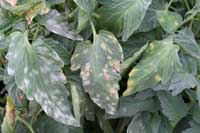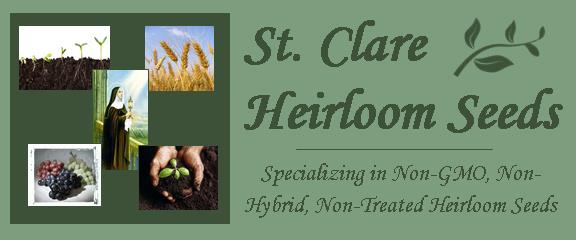Scott C. Ockey/Plant Disease Diagnostician

Powdery mildew on Tomatoes, caused by the fungus Leveillula taurica, occurs infrequently in home gardens. However, the disease can be very devastating in commercially-grown tomatoes where yield losses may exceed 50% in heavily infected fields. The extent of loss depends on environmental conditions, date of disease onset, and effectiveness of fungicide control. Hot, dry days with an occasional rainstorm are conducive to disease development.
Powdery Mildew on Tomatoes
Symptoms: The first symptom of powdery mildew on Tomatoes occur on lower leaves as bright yellow spots that range from 1/8 to 1/2 inch in diameter. The spots enlarge and eventually turn brown. As infections progress, the entire leaf withers and dies but remains attached to the stem. There are no symptoms on the stems or fruit. However, with extensive loss of foliage, many exposed fruit will sunburn. Despite the name, powdery mildew, it is rare to find heavy sporulation of the fungus on leaves in Utah.
Disease Cycle: The fungus does not overwinter outdoors in northern Utah and must be reintroduced each year on tomato transplants grown in Nevada or other areas of the Southwest where the fungus over winters. Transplants from Florida, Georgia, and Texas have not been shown to carry the disease. Locally-grown transplants, if grown in a greenhouse free of the disease, are the best assurance of a healthy crop. Since powdery mildew spores are airborne and are blown north with prevailing wind currents, most plantings in northern Utah have low levels of disease by late summer. These late-season infections do not result in significant losses.
Control of Powdery Mildew on Tomatoes
Control: The use of healthy, locally-grown plants may eliminate the need for applying a fungicide later in the year. Sulfur sprays or dusts are effective if complete coverage applications start early and are repeated every seven to ten days. Plant damage by ground equipment can be reduced by leaving space at planting time for wheel tracks. Flowable sulfur may provide better protection than wettable sulfur because of the highly adhesive property and because it stays in suspension longer, thus preventing obstruction of spray nozzles. When using transplants from areas where the fungus over winters, applications of a fungicide should begin before any symptoms are apparent, usually in the first 10 days of July. Visual inspection of the lower leaves should be made on a weekly basis beginning in late June. When symptoms are seen, the fungicide program should be closely followed. Thorough coverage is critical for effective control, and repeated applications are necessary. The only fungicide currently registered for use on tomatoes is sulfur. Fungicides are usually not necessary when using disease-free transplants. Sulfur may cause phytotoxicity (burning) if applied when temperatures exceed 95 F. Therefore, make applications during cool weather and in the evening. Some sulfur labels indicate that applications should not be made within 40 days of harvest if the tomatoes are to be canned in metal containers. Check with your buyer to determine if this precaution needs to be followed. The following list of fungicides are not specifically labeled for control of powdery mildew of heirloom tomato’s. However, it is legal to follow the directions suggested for control of tomato russet mite.
Sulfur:
- Wettable powder– Wilbur Ellis Red Top Spray Sulfur 97%, 6-10 lbs/acre; FMC-Kolo
- spray 81.25%, 7 lbs/acre, full coverage;
- Home use: Lilly Miller Sulfur or Ortho Flotox 90%.
- Dust– FMC-Kolo dust or Wilbur Ellis Redtop Ben-sul 60%, 40-55 lbs/acre, full coverage;
- Home use: Lilly Miller Sulfur or Ortho Flotox 90%, dust to cover.
- Flowable– 1/2 – 1 gal/acre full coverage.
- Stauffer Magnetic Six; Stoller-That or That Big 8 (64%)
- Dry Flowable 80%– Sandoz Thiolux, 3-10 lbs/acre.

